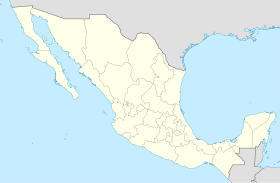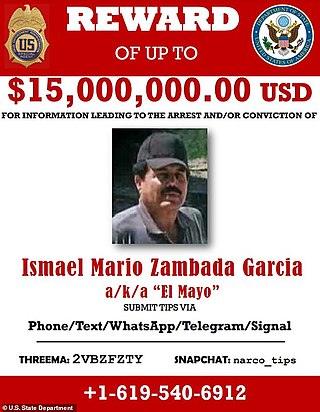
Ismael Mario Zambada García is a Mexican drug lord, co-founder and current top leader of the Sinaloa Cartel, an international crime syndicate based in Sinaloa. Before he assumed leadership of the entire cartel, he allegedly served as the logistical coordinator for its Guzmán-Zambada organization, which has overseen the trafficking of cocaine and heroin into Chicago and other US cities by aircraft, narcosubs, container ships, go-fast boats, fishing vessels, buses, rail cars, tractor trailers, and automobiles. As of early 2023, he has never been arrested or incarcerated and is the single last remaining fugitive of the List of Mexico's 37 most-wanted drug lords (2009).

Nuevo Laredo is a city in the Municipality of Nuevo Laredo in the Mexican state of Tamaulipas. The city lies on the banks of the Rio Grande, across from Laredo, United States. The 2010 census population of the city was 373,725. Nuevo Laredo is part of the Laredo-Nuevo Laredo Metropolitan Area with a population of 636,516. The municipality has an area of 1,334.02 km2 (515.07 sq mi). Nuevo Laredo is considered the “customs capital of Latin America” because of its high volume of international trade operations in the region,and number 1 in importance for US inland commercial traffic. Both the city and the municipality rank as the third largest in the state.

Los Zetas is a Mexican criminal syndicate and terrorist organization, known as one of the most dangerous of Mexico's drug cartels. They are known for engaging in brutally violent "shock and awe" tactics such as beheadings, torture, and indiscriminate murder. While primarily concerned with drug trafficking, the organization also runs profitable sex and gun rackets. Los Zetas also operate through protection rackets, assassinations, extortion, kidnappings and other illegal activities. The organization is based in Nuevo Laredo, Tamaulipas, directly across the border from Laredo, Texas. The origins of Los Zetas date back to the late 1990s, when commandos of the Mexican Army deserted their ranks and began working as the enforcement arm of the Gulf Cartel. In February 2010, Los Zetas broke away and formed their own criminal organization, rivalling the Gulf Cartel.

The Gulf Cartel is a criminal syndicate and drug trafficking organization in Mexico, and perhaps one of the oldest organized crime groups in the country. It is currently based in Matamoros, Tamaulipas, directly across the U.S. border from Brownsville, Texas.
Los Negros was a criminal organization that was once the armed wing of the Sinaloa Cartel and after a switch of alliances, became the armed wing of the Sinaloa splinter gang, the Beltrán-Leyva Cartel. In 2010 it went independent and had been contesting the control of the Beltrán-Leyva Cartel. It was then the criminal paramilitary unit of Édgar Valdez Villarreal in Mexico. Valdez was arrested on August 30, 2010, near Mexico City. Los Negros was led by Valdez at the time they merged with the Sinaloa Cartel.
The timeline of some of the most relevant events in the Mexican drug war is set out below. Although violence between drug cartels had been occurring for three decades, the Mexican government held a generally passive stance regarding cartel violence through the 1980s and early 2000s.

Miguel Ángel Treviño Morales, commonly referred to by his alias Z-40, is a Mexican former drug lord and leader of the criminal organization known as Los Zetas. Considered a violent, resentful and dangerous criminal, he was one of Mexico's most-wanted drug lords until his arrest in July 2013.

The Jalisco New Generation Cartel or CJNG, formerly known as Los Mata Zetas, is a Mexican organized crime syndicate based in Jalisco which is headed by Nemesio Oseguera Cervantes, one of the world's most-wanted drug lords. The cartel has been characterized by its aggressive use of extreme violence and its public relations campaigns. Although the CJNG is particularly known for diversifying into various types of criminal rackets, drug trafficking remains its most profitable activity. The cartel has also been noted for cannibalizing some of its victims, sometimes during the training of new sicarios or cartel members, as well as using drones and rocket-propelled grenades to attack its enemies.
The 2012 Nuevo Laredo massacres were a series of mass murder attacks between the allied Sinaloa Cartel and Gulf Cartel against Los Zetas in the border city of Nuevo Laredo, Tamaulipas, across the U.S.-Mexico border from Laredo, Texas. The drug-violence in Nuevo Laredo began back in 2003, when the city was controlled by the Gulf Cartel. Most media reports that write about the Mexican Drug War, however, point to 2006 as the start of the drug war. That year is a convenient historical marker because that's when Felipe Calderón took office and carried out an aggressive approach against the cartels. But authors like Ioan Grillo and Sylvia Longmire note that Mexico's drug war actually began at the end of Vicente Fox's administration in 2004, when the first major battle took place in Nuevo Laredo between the Sinaloa Cartel and Los Zetas, who at that time worked as the armed wing of the Gulf Cartel.
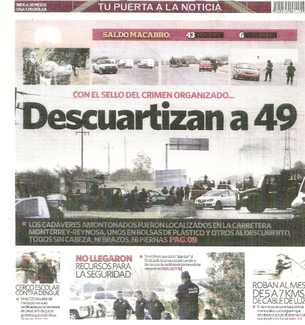
The Cadereyta Jiménez massacre occurred on the Fed 40 on 12–13 May 2012. Mexican officials stated that 49 people were decapitated and mutilated by members of Los Zetas drug cartel and dumped by a roadside near the city of Cadereyta Jiménez in northern Mexico. The Blog del Narco, a blog that documents events and people of the Mexican Drug War anonymously, reported that the actual (unofficial) death toll may be more than 68 people. The bodies were found in the town of San Juan in the municipality of Cadereyta Jiménez, Nuevo León at about 4 a.m. on a non-toll highway leading to Reynosa, Tamaulipas. The forty-three men and six women killed had their heads, feet, and hands cut off, making their identification difficult. Those killed also bore signs of torture and were stuffed in plastic bags. The arrested suspects have indicated that the victims were Gulf Cartel members, but the Mexican authorities have not ruled out the possibility that they were U.S.-bound migrants. Four days before this incident, 18 people were found decapitated and dismembered near Mexico's second largest city, Guadalajara.
In 2011 and 2012, during the Mexican drug war, hundreds of people were killed in massacres by rival drug cartels who were fighting for power and territory. These organized-crime syndicates were grappling for control over the drug corridors to the United States, the drug markets in local cities, extortion rackets, and human smuggling. Massacres occurred in the states of Veracruz, Sinaloa, Jalisco, Tamaulipas and Nuevo León.
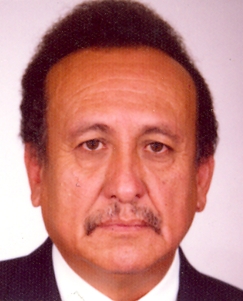
José Antonio García Apac, also known as "El Chino", was a Mexican journalist and editor for the Ecos de la Cuenca in Tepalcatepec, Michoacán, Mexico, when he disappeared 20 November 2006. He is best known for the news stories he published on the violent relationship between the drug cartels in his home state and its authorities.
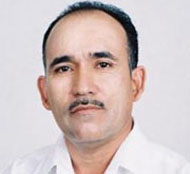
José Luis Romero, was a Mexican radio journalist for Línea Directa Radio and Radio Sistema del Noroeste in Los Mochis, Sinaloa, Mexico, and he was known for his reporting about drug trafficking. Romero was a journalist for roughly 20 years and had been with Línea Directa for ten years. He had been missing for two weeks until his body was found tortured and brutally murdered. Romero's murder, along with other Mexican journalists who have been killed during their job, was interpreted by CNN as intimidation toward journalists.
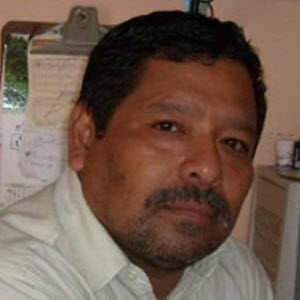
On 13 August 2012, Mario Segura, a Mexican journalist who served as an editor for El Sol del Sur Tampico, a regional newspaper in Tampico, Tamaulipas, was abducted by a drug cartel. He was released a week later and was forced to relocate with his family to Mexico City, where he became a clown as he could no longer get a job as a journalist. Mario Segura is one of at least 30 Mexican journalists who have had to relocate because of threats and violence.

Roberto Javier Mora García was a Mexican journalist and editorial director of El Mañana, a newspaper based in Nuevo Laredo, Tamaulipas, Mexico. He worked for a number of media outlets in Mexico, including the El Norte and El Diario de Monterrey, prior to his assassination.

Dolores Guadalupe García Escamilla was a Mexican crime reporter and anchorwoman for Punto Rojo, a radio show on XHNOE-FM radio based in Nuevo Laredo, Tamaulipas, Mexico. She had experience in a number of news platforms and was a radio personality and crime reporter since 2001.

Fausto Isidro Meza Flores alias "El Chapo Isidro", is a Mexican drug lord and leader of Los Mazatlecos. He has a high-ranking in the Beltrán Leyva Cartel and was the right-hand man of Alfredo Beltrán Leyva before he got incarcerated in United States.
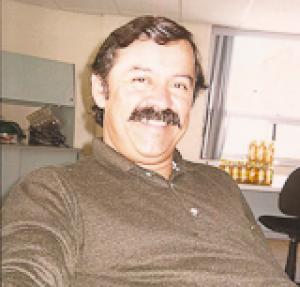
Norberto Miranda Madrid,, also known as "El Gallito", was a Mexican editor, radio show host and online columnist for Radio Visión in Nuevo Casas Grandes, Chihuahua state, northern Mexico. He was targeted in the workplace by the Juárez Cartel in an attack at the radio because of his reporting on an affiliated group's campaign of violence in the area.
This is a list of events that happened in 2014 in Mexico. The article also lists the most important political leaders during the year at both federal and state levels.
